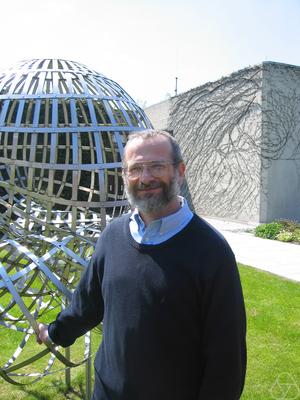
In topology, knot theory is the study of mathematical knots. While inspired by knots which appear in daily life, such as those in shoelaces and rope, a mathematical knot differs in that the ends are joined so it cannot be undone, the simplest knot being a ring. In mathematical language, a knot is an embedding of a circle in 3-dimensional Euclidean space, . Two mathematical knots are equivalent if one can be transformed into the other via a deformation of upon itself ; these transformations correspond to manipulations of a knotted string that do not involve cutting it or passing it through itself.

In the mathematical field of knot theory, a knot polynomial is a knot invariant in the form of a polynomial whose coefficients encode some of the properties of a given knot.
Skein relations are a mathematical tool used to study knots. A central question in the mathematical theory of knots is whether two knot diagrams represent the same knot. One way to answer the question is using knot polynomials, which are invariants of the knot. If two diagrams have different polynomials, they represent different knots. In general, the converse does not hold.
In mathematics, the classical orthogonal polynomials are the most widely used orthogonal polynomials: the Hermite polynomials, Laguerre polynomials, Jacobi polynomials.
In linear algebra, a Hankel matrix, named after Hermann Hankel, is a square matrix in which each ascending skew-diagonal from left to right is constant, e.g.:

In knot theory, a branch of mathematics, the trefoil knot is the simplest example of a nontrivial knot. The trefoil can be obtained by joining the two loose ends of a common overhand knot, resulting in a knotted loop. As the simplest knot, the trefoil is fundamental to the study of mathematical knot theory.
In mathematics, specifically algebraic topology, the cohomology ring of a topological space X is a ring formed from the cohomology groups of X together with the cup product serving as the ring multiplication. Here 'cohomology' is usually understood as singular cohomology, but the ring structure is also present in other theories such as de Rham cohomology. It is also functorial: for a continuous mapping of spaces one obtains a ring homomorphism on cohomology rings, which is contravariant.
In the mathematical field of knot theory, the Jones polynomial is a knot polynomial discovered by Vaughan Jones in 1984. Specifically, it is an invariant of an oriented knot or link which assigns to each oriented knot or link a Laurent polynomial in the variable with integer coefficients.
In mathematics, the Alexander polynomial is a knot invariant which assigns a polynomial with integer coefficients to each knot type. James Waddell Alexander II discovered this, the first knot polynomial, in 1923. In 1969, John Conway showed a version of this polynomial, now called the Alexander–Conway polynomial, could be computed using a skein relation, although its significance was not realized until the discovery of the Jones polynomial in 1984. Soon after Conway's reworking of the Alexander polynomial, it was realized that a similar skein relation was exhibited in Alexander's paper on his polynomial.

Józef Henryk Przytycki, is a Polish mathematician specializing in the fields of knot theory and topology.
In mathematics, Khovanov homology is an oriented link invariant that arises as the cohomology of a cochain complex. It may be regarded as a categorification of the Jones polynomial.
The Tait conjectures are three conjectures made by 19th-century mathematician Peter Guthrie Tait in his study of knots. The Tait conjectures involve concepts in knot theory such as alternating knots, chirality, and writhe. All of the Tait conjectures have been solved, the most recent being the Flyping conjecture.
In the mathematical field of knot theory, a chiral knot is a knot that is not equivalent to its mirror image. An oriented knot that is equivalent to its mirror image is an amphicheiral knot, also called an achiral knot. The chirality of a knot is a knot invariant. A knot's chirality can be further classified depending on whether or not it is invertible.
In knot theory, the Kauffman polynomial is a 2-variable knot polynomial due to Louis Kauffman. It is initially defined on a link diagram as

William Bernard Raymond Lickorish is a mathematician. He is emeritus professor of geometric topology in the Department of Pure Mathematics and Mathematical Statistics, University of Cambridge, and also an emeritus fellow of Pembroke College, Cambridge. His research interests include topology and knot theory. He was one of the discoverers of the HOMFLY polynomial invariant of links, and proved the Lickorish-Wallace theorem which states that all closed orientable 3-manifolds can be obtained by Dehn surgery on a link.
In mathematics, the Kostant polynomials, named after Bertram Kostant, provide an explicit basis of the ring of polynomials over the ring of polynomials invariant under the finite reflection group of a root system.
In the mathematical study of rotational symmetry, the zonal spherical harmonics are special spherical harmonics that are invariant under the rotation through a particular fixed axis. The zonal spherical functions are a broad extension of the notion of zonal spherical harmonics to allow for a more general symmetry group.
Kenneth C. Millett is a professor of mathematics at the University of California, Santa Barbara. His research concerns low-dimensional topology, knot theory, and the applications of knot theory to DNA structure; his initial is the "M" in the name of the HOMFLY polynomial.
In the mathematical field of quantum topology, the Reshetikhin–Turaev invariants (RT-invariants) are a family of quantum invariants of framed links. Such invariants of framed links also give rise to invariants of 3-manifolds via the Dehn surgery construction. These invariants were discovered by Nicolai Reshetikhin and Vladimir Turaev in 1991, and were meant to be a mathematical realization of Witten's proposed invariants of links and 3-manifolds using quantum field theory.




















